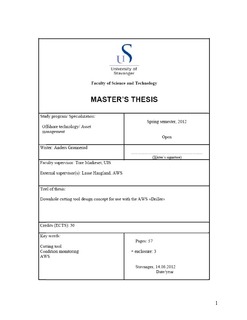| dc.contributor.author | Grønnerød, Anders | |
| dc.date.accessioned | 2012-10-15T12:18:30Z | |
| dc.date.available | 2012-10-15T12:18:30Z | |
| dc.date.issued | 2012 | |
| dc.identifier.uri | http://hdl.handle.net/11250/182952 | |
| dc.description | Master's thesis in Offshore technology | no_NO |
| dc.description.abstract | Production tubing cutting operations is getting more and more common in the North Sea; this is a
product of an increasing number of Plug and Abandonment operations and re-completions of old
wells. The most common method of cutting production tubing has for a long time been explosive
cutters. These cutters are relatively simple in use, cheap to produce and quite reliable. However,
explosive cutters are as the name implies containing explosives. Explosive handling offshore
should be kept to a minimum since the consequence of an explosion during handling of these
types of cutters would most likely be fatal. Together with the other disadvantages of explosive
cutters a non-explosive cutter should always be considered for the job.
The goal with this thesis was to design a non-explosive cutting tool that could be powered by an
already existing Electro-Mechanical AWS tool. A part of this task it has been to present some of
the already existing cutting tools on the market.
Further basic well design is described to give a better understanding of why downhole cutting
tools are needed. Different completion parts are described together with some examples of why
the production tubing needs to be cut and removed.
An interview with 3 different oil companies has also been conducted. This interview indicates
that these three operator companies are positive with running Electro-Mechanical cutting tools in
the future.
There is also a chapter in this thesis where it is discussed how condition monitoring can be
implemented in the between-job maintenance of the cutting concept. These techniques could be
used by any other tool suitable for condition monitoring.
It is in this thesis concluded that this design concept can be a developed into a functioning
cutting tool, if an appropriate centralization mechanism is developed. It does also conclude that
condition monitoring should be implemented in the between run maintenance of downhole tools
suitable for condition monitoring. | no_NO |
| dc.language.iso | eng | no_NO |
| dc.publisher | University of Stavanger, Norway | no_NO |
| dc.relation.ispartofseries | Masteroppgave/UIS-TN-IKM/2012; | |
| dc.subject | cutting | no_NO |
| dc.subject | well | no_NO |
| dc.subject | driftsledelse | no_NO |
| dc.subject | offshore teknologi | no_NO |
| dc.subject | AWS | no_NO |
| dc.subject | condition monitoring | no_NO |
| dc.title | Downhole cutting tool design concept for use with the AWS “Driller” | no_NO |
| dc.type | Master thesis | no_NO |
| dc.subject.nsi | VDP::Technology: 500::Marine technology: 580::Offshore technology: 581 | no_NO |
